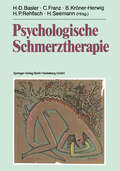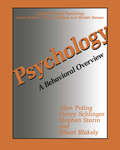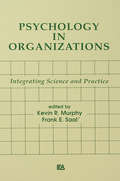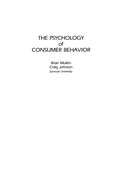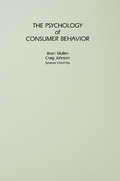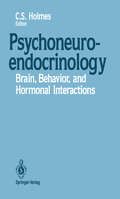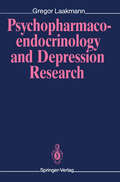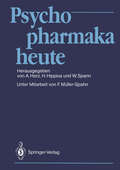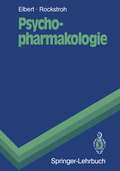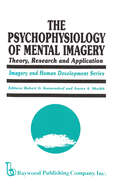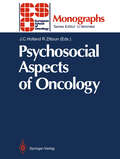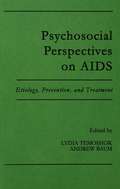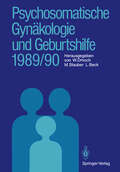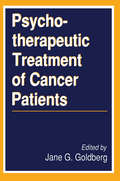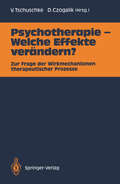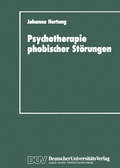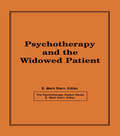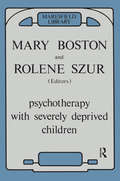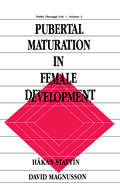- Table View
- List View
Psychologische Schmerztherapie: Grundlagen, Diagnostik, Krankheitsbilder, Behandlung
by Heinz-Dieter Basler Carmen Franz Birgit Kröner-Herwig Hans P. Rehfisch Hanne SeemannPsychology: A Behavioral Overview (Nato Science Series B:)
by Alan Poling Henry Schlinger Stephen Starin Elbert BlakelyPsychology: A Behavioral Overview is an introductory text with an orienting per spective that is frankly behavioral rather than eclectic. This focus is made quite clear in the first chapter of the book, but in the remainder it also becomes clear that such a focus permits coverage of most of the topics found in the more common introductory text. Actually, the next five chapters (dealing with psy chology as a scienc~, methodology, evolution, physiology, and learning) are in many ways comparable to the treatments provided in more eclectic introductory texts. The behavioral focus and the departure from traditional approaches be come most significant in the last six chapters which deal with traditional psycho logical topics (e. g. , language, child development, and personality)-but deal with them systematically in terms of the concepts and principles introduced in the chapters on evolution and physiology, and especially in the chapter on learning. Using the concepts provided early in the text to interpret complex aspects of human behavior provides valuable justification for those concepts, as well as an opportunity for improved understanding of them. Although students will not make extensive contact with the variety of the oretical approaches found in the typical text, they will become especially compe tent in the use of behavioral concepts and principles to interpret and understand many of the topics of traditional importance in psychology.
Psychology in Organizations: integrating Science and Practice (Applied Psychology Series)
by Kevin R. Murphy Frank E. SaalThis book deals with two key questions. First, is there a firm scientific basis for the major applications of psychology in organizations? Second, does the practice of psychology in organizations contribute in any meaningful way to psychological research? This text attempts to answer these questions by describing some of the unique ways in which Industrial/Organizational (I/O) psychologists integrate science and practice in applying psychology in organizations. The editors of this volume believe that there is great potential for the effective interplay of science and practice in I/O psychology. Aware, however, that much work must still be done before a truly effective integration can be achieved and maintained, they have created a text that offers specific suggestions for improvement as well as many examples of successful integration. Psychology in Organizations explores the unique relationship between science and practice within industrial/organizational psychology. The contributors seek to answer two main questions: * Is there a firm scientific basis for the major applications of psychology in organizations? * Does the practice of psychology in organizations contribute in any meaningful way to psychological research? After an initial examination of the industrial/organizational psychologist as a scientist and practitioner, Psychology in Organizations looks at specific roles played in such issues as job performance and productivity, sexual harassment, drug abuse, and drug testing. A final chapter looks at both the past and future of the field and suggests future applications.
Psychology in Organizations: integrating Science and Practice (Applied Psychology Series)
by Kevin R. Murphy Frank E. SaalThis book deals with two key questions. First, is there a firm scientific basis for the major applications of psychology in organizations? Second, does the practice of psychology in organizations contribute in any meaningful way to psychological research? This text attempts to answer these questions by describing some of the unique ways in which Industrial/Organizational (I/O) psychologists integrate science and practice in applying psychology in organizations. The editors of this volume believe that there is great potential for the effective interplay of science and practice in I/O psychology. Aware, however, that much work must still be done before a truly effective integration can be achieved and maintained, they have created a text that offers specific suggestions for improvement as well as many examples of successful integration. Psychology in Organizations explores the unique relationship between science and practice within industrial/organizational psychology. The contributors seek to answer two main questions: * Is there a firm scientific basis for the major applications of psychology in organizations? * Does the practice of psychology in organizations contribute in any meaningful way to psychological research? After an initial examination of the industrial/organizational psychologist as a scientist and practitioner, Psychology in Organizations looks at specific roles played in such issues as job performance and productivity, sexual harassment, drug abuse, and drug testing. A final chapter looks at both the past and future of the field and suggests future applications.
The Psychology of Consumer Behavior
by Brian Mullen Craig JohnsonAfter years of study in the area of consumer behavior, Mullen and Johnson bring together a broad survey of small answers to a big question: "Why do consumers do what they do?" This book provides an expansive, accessible presentation of current psychological theory and research as it illuminates fundamental issues regarding the psychology of consumer behavior. The authors hypothesize that an improved understanding of consumer behavior could be employed to more successfully influence consumers' use of products, goods, and services. At the same time, an improved understanding of consumer behavior might be used to serve as an advocate for consumers in their interactions in the marketplace.
The Psychology of Consumer Behavior
by Brian Mullen Craig JohnsonAfter years of study in the area of consumer behavior, Mullen and Johnson bring together a broad survey of small answers to a big question: "Why do consumers do what they do?" This book provides an expansive, accessible presentation of current psychological theory and research as it illuminates fundamental issues regarding the psychology of consumer behavior. The authors hypothesize that an improved understanding of consumer behavior could be employed to more successfully influence consumers' use of products, goods, and services. At the same time, an improved understanding of consumer behavior might be used to serve as an advocate for consumers in their interactions in the marketplace.
Psychoneuroendocrinology: Brain, Behavior, and Hormonal Interactions
by Clarissa S. Holmesmore intuitive study to greater empiricism. Frequently, chapters are di vided into discrete sections to discuss each rather distinct era of inquiry. This approach, when used, can provide a valuable historical overview of the early clinical formulations about each disease. Even though many of the earlier research philosophies and techniques may seem so simplistic as to mitigate against their inclusion, early research hypotheses were often generated from astute observation of clinical findings and relationships. In addition to shaping later empirical questions, a review of historical ante cedents provides a yardstick by which to measure the progress of more current studies, even though much is yet to be learned. As is true of any refinement of knowledge, the juxtaposition of the two approaches of study reveals that some of the early postulations about patient attributes and disease consequences have been confirmed, while other suppositions have been discarded. Although the generally subjective assessment methods used in the early studies may not have provided an optimal data base, it is interesting to note which clinical impressions were able to withstand greater empirical rigor and which were not. The book at its inception was intended to provide a succinct introduc tion to psychoneuroendocrinology research for practitioners and scientists who might be relatively unfamiliar with the area. However, it quickly became apparent that the sophistication of the information could not be readily reduced without vast oversimplification and loss of substance.
Psychopharmacoendocrinology and Depression Research
by Gregor Laakmann1.1 Outline of the Study In this study the influence of psychotropic drugs on anterior pituitary hormone (APR) secretion was investigated in healthy subjects and in depressed patients. The basis for this study is formed by pharmacological investigations which indicate that the therapeutic effect of psychotropic drugs can be attributed to their functional influence on central nervous aminergic impulse transmission (stimuli) as well as by endocrinological investigations which show that central nervous aminergic neurons influence APR secretion in man. The purpose was to frod out if psychotropic drugs with differing pharmacological actions also influence APR secretion differently, even though the complex processes of central nervous stimuli transmission, the effect of psychotropic drugs on these processes, as well as the action of aminergic neuronal systems on APR secretion are not completely understood. Furthermore, it was investigated if it is possible to reach conclusions on the effects of drugs on central nervous aminergic neurons based upon APR secretion data. Specifically, the effects of various antidepressants, neuroleptics, and benzodiazepine-type tranquilizers on the secretion of growth hormone (GR), prolactin (PRL), adrenocorticotropic hormone (ACTR), and cortisol were investigated in healthy male subjects. The first part of this study presents in detail the results of these experiments and also incorporates the results of other investigators. It is endeavored to answer the question whether and to what extent the different psychotropic drugs influence APR secretion and whether the APR secretion profiles of the different psychotropic drugs can serve as a possible pharmacoendocrinological model in humans.
Psychopharmaka heute
by F. Müller-Spahn W. SpannDie Neurobiologie und die Pharmakotherapie verschiedener psychiatrischer Krankheitsbilder sind der Inhalt dieses Buches. Neue Aspekte sowohl in der Forschung als auch bei der Therapie werden dargestellt. Deshalb gehört dieses Buch in das Regal sowohl des Forschers als auch des verantwortungsbewußten Praktikers.
Psychopharmakologie: Anwendung und Wirkungsweise von Psychopharmaka und Drogen (Springer-Lehrbuch)
by Thomas Elbert Brigitte RockstrohThe Psychophysiology of Mental Imagery: Theory, Research, and Application (Imagery and Human Development Series)
by Robert G. Kunzendorf Anees Ahmad SheikhServing to bridge the gap between differing approaches to psychology, this new text provides some of the most compelling evidence yet for the subjective presence and objective efficacy of the mental image. In this day and age of "dissociation" between physiological psychologists and other psychologists, between cognitive scientist and mentalist, between researchers and practitioners, mental imagery and its psychophysiology pose some intellectually "sticky" problems - and some promising resolutions - that should bind together differing disciplines within psychology.
The Psychophysiology of Mental Imagery: Theory, Research, and Application (Imagery and Human Development Series)
by Robert G. Kunzendorf Anees Ahmad SheikhServing to bridge the gap between differing approaches to psychology, this new text provides some of the most compelling evidence yet for the subjective presence and objective efficacy of the mental image. In this day and age of "dissociation" between physiological psychologists and other psychologists, between cognitive scientist and mentalist, between researchers and practitioners, mental imagery and its psychophysiology pose some intellectually "sticky" problems - and some promising resolutions - that should bind together differing disciplines within psychology.
Psychosocial Aspects of Oncology (ESO Monographs)
by Jimmie C. Holland and Robert ZittounThe European School of Oncology came into existence to respond to a need for information, education and training in the field of the diagnosis and treatment of cancer. There are two main reasons why such an initiative was considered necessary. Firstly, the teaching of oncology requires a rigorously multidiscipli nary approach which is difficult for the Universities to put into practice since their system is mainly disciplinary orientated. Secondly, the rate of technological development that impinges on the diagnosis and treatment of cancer has been so rapid that it is not an easy task for medical faculties to adapt their curricula flexibly. With its residential courses for organ pathologies and the seminars on new techniques (laser, monoclonal antibodies, imaging techniques etc.) or on the prinr.ir~-' ther::!PG~tic c0r'liuversies (conservative or mutilating surgery, primary or adjuvant chemotherapy, radiotherapy alone or integrated), it is the ambition of the European School of Oncology to fill a cultural and scientific gap and, thereby, create a bridge between the University and Industry and between these two and daily medical practice. One of the more recent initiatives of ESO has been the institution of permanent study groups, also called task forces, where a limited number of leading experts are invited to meet once a year with the aim of defining the state of the art and possibly reaching a consensus on future developments in specific fields of on cology.
Psychosocial Perspectives on Aids: Etiology, Prevention and Treatment
by Lydia Temoshok Andrew BaumAIDS and the virus that causes it have challenged the world's scientists, health care systems, and public health policies as much or more than any medical problem in recorded history. Perhaps this is so because this particular infirmity constitutes more than a merely medical problem: it is enmeshed in psychological, social, cultural, political, and economic contexts. This book examines the need for pragmatic and research-based suggestions on how to address some important problems related to these contexts. Although much basic research in virology and immunology can be accomplished within the biomedical domain, biobehavioral disciplines such as behavioral medicine offer more opportunities for the comprehensive approach necessary to confront the AIDS/HIV problem. The editors of this groundbreaking volume suggest that the very nature of this constantly evolving problem encourages an approach to research and intervention/prevention efforts that emphasizes flexibility of response to changing knowledge, patterns of the pandemic, new treatments, and shifts in public opinion and behavior. A major triumph in dealing with this phenomenon would include a bridging of the gap between research and applied efforts, which has been the largest obstacle for progress to date. In this book, such previously uncharted territory is explored, opening a host of new possibilities for dealing with the very real threat of AIDS.
Psychosocial Perspectives on Aids: Etiology, Prevention and Treatment
by Lydia Temoshok Andrew S. BaumAIDS and the virus that causes it have challenged the world's scientists, health care systems, and public health policies as much or more than any medical problem in recorded history. Perhaps this is so because this particular infirmity constitutes more than a merely medical problem: it is enmeshed in psychological, social, cultural, political, and economic contexts. This book examines the need for pragmatic and research-based suggestions on how to address some important problems related to these contexts. Although much basic research in virology and immunology can be accomplished within the biomedical domain, biobehavioral disciplines such as behavioral medicine offer more opportunities for the comprehensive approach necessary to confront the AIDS/HIV problem. The editors of this groundbreaking volume suggest that the very nature of this constantly evolving problem encourages an approach to research and intervention/prevention efforts that emphasizes flexibility of response to changing knowledge, patterns of the pandemic, new treatments, and shifts in public opinion and behavior. A major triumph in dealing with this phenomenon would include a bridging of the gap between research and applied efforts, which has been the largest obstacle for progress to date. In this book, such previously uncharted territory is explored, opening a host of new possibilities for dealing with the very real threat of AIDS.
Psychosomatische Gynäkologie und Geburtshilfe 1989/90
by Walter Dmoch Manfred Stauber Lutwin BeckDas Buch enthält die Vorträge des XVIII. Seminarkongresses 1989 für Psychosomatische Gynäkologie und Geburtshilfe. Die Beiträge behandeln u. a. Bilder der Weiblichkeit, Schwangerschaftskonflikt, Pubertät und Adoleszenz sowie aktuelle Themen aus Forschung und Praxis. Der neue Band dieser Fortbildungsreihe vermittelt Gynäkologen, interessierten Ärzten anderer medizinischer Fachdisziplinen sowie klinisch tätigen Psychologen das relevante notwendige Wissen über psychosomatische Zusammenhänge und Störungen. Es enthält praxisnahe Hinweise für eine erfolgreiche Behandlung auf diesem für Arzt und Patientin problematischen Gebiet.
Psychotherapeutic Treatment of Cancer Patients
by Albert BanduraWhen this book first appeared in 1981, it was the first to deal comprehensively with major issues in the psychotherapeutic treatment of cancer patients. It remains the standard volume in the field, drawing together a broad spectrum of work using psychological approaches to treatment of cancer patients and to understanding the disease's sociological and psychological implications. Distinguished contributors from medicine, psychiatry, psychoanalysis, psychology, social work, family and group therapy, and nursing examine key issues, including the role of aggression in the onset and treatment of cancer; sexual functioning of patients; cancer as an emotionally regressive experience, cancer in children, and the countertransference responses of a therapist working with a cancer patient. This volume will be of particular value to helping professionals who deal with cancer patients and their families.
Psychotherapeutic Treatment of Cancer Patients
by Jane G. GoldbergWhen this book first appeared in 1981, it was the first to deal comprehensively with major issues in the psychotherapeutic treatment of cancer patients. It remains the standard volume in the field, drawing together a broad spectrum of work using psychological approaches to treatment of cancer patients and to understanding the disease's sociological and psychological implications. Distinguished contributors from medicine, psychiatry, psychoanalysis, psychology, social work, family and group therapy, and nursing examine key issues, including the role of aggression in the onset and treatment of cancer; sexual functioning of patients; cancer as an emotionally regressive experience, cancer in children, and the countertransference responses of a therapist working with a cancer patient. This volume will be of particular value to helping professionals who deal with cancer patients and their families.
Psychotherapie — Welche Effekte verändern?: Zur Frage der Wirkmechanismen therapeutischer Prozesse
by Volker Tschuschke Dietmar CzogalikDie Frage nach der Effizienz von Psychotherapie ist in neuerer Zeit abgelöst worden von der Frage: Was trägt entscheidend zur psychotherapeutischen Wirkung bei? Damit verbunden ist ein zunehmender Konsens, daß verschiedene therapeutische Techniken und Konzepte zum Gesamtwissen der Psychotherapie und der Wirkung von Psychotherapie ihre jeweiligen Beiträge leisten können. Der Aspekt der Schulenzugehörigkeit und der theoretischen Orientierung tritt somit zunehmend in den Hintergrund. Der Leser erhält Einblicke, welche Mechanismen in Psychotherapien allen Schulen gemeinsam zu sein scheinen und welche nicht. Die relevanten Wirkelemente in verschiedensten therapeutischen Techniken werden im Hinblick auf Ähnlichkeit und Gemeinsamkeit sowie auf differentielle Effekte analysiert und so konzeptübergreifend dargestellt.
Psychotherapie phobischer Störungen: Zur Handlungs- und Lageorientierung im Therapieprozeß
by Johanna HartungPsychotherapy and the Widowed Patient
by E Mark SternComing at a time of renewed interest in the developmental changes of the life cycle, Psychotherapy and the Widowed Patient is a rich resource that examines the impact of a spouse's death on an individual's mental health. Psychiatrists and psychoanalysts address a wide range of issues concerning loss, grief, and bereavement, and provide practical and creative approaches for both widowed persons and the helping professionals charged with treating their grief. Chapters in this compassionate volume discuss the characteristics of individuals who are more likely to seek professional help in coping with grief, widowhood as a time of growth and development, the value of openness instead of denial in dealing with death, the grieving process in young widowed spouses, the similarities of widowhood to separation and divorce, the role of dependency in how well widowed patients develop emotionally, and the role of loyalty in the process of grief. The more clinical chapters examine strategies for carrying out experiential psychotherapy with widowed patients, rational-emotive therapy, grief therapy, the effects of new perspectives on spousal bereavement on clinical practice, and aspects of bereavement response to loss, with a timeframe for viewing psychotherapeutic intervention. A review of the psychological literature regarding widowhood completes this comprehensive new book.
Psychotherapy and the Widowed Patient
by E Mark SternComing at a time of renewed interest in the developmental changes of the life cycle, Psychotherapy and the Widowed Patient is a rich resource that examines the impact of a spouse's death on an individual's mental health. Psychiatrists and psychoanalysts address a wide range of issues concerning loss, grief, and bereavement, and provide practical and creative approaches for both widowed persons and the helping professionals charged with treating their grief. Chapters in this compassionate volume discuss the characteristics of individuals who are more likely to seek professional help in coping with grief, widowhood as a time of growth and development, the value of openness instead of denial in dealing with death, the grieving process in young widowed spouses, the similarities of widowhood to separation and divorce, the role of dependency in how well widowed patients develop emotionally, and the role of loyalty in the process of grief. The more clinical chapters examine strategies for carrying out experiential psychotherapy with widowed patients, rational-emotive therapy, grief therapy, the effects of new perspectives on spousal bereavement on clinical practice, and aspects of bereavement response to loss, with a timeframe for viewing psychotherapeutic intervention. A review of the psychological literature regarding widowhood completes this comprehensive new book.
Psychotherapy with Severely Deprived Children (Psychology Revivals Ser.)
by Mary Boston Rolene SzurThis book draws on the experience of some eighty severely deprived children referred for individual psychoanalytic psychotherapy to the Tavistock and other clinics and schools in the London area. It describes how child psychotherapists found themselves treating the severely deprived children.
Psychotherapy with Severely Deprived Children
by Mary Boston Rolene SzurThis book draws on the experience of some eighty severely deprived children referred for individual psychoanalytic psychotherapy to the Tavistock and other clinics and schools in the London area. It describes how child psychotherapists found themselves treating the severely deprived children.
Pubertal Maturation in Female Development (Paths Through Life Series)
by H†kan Stattin David Magnusson Hakan StattinResearch on physical maturity has demonstrated conclusively that the assumption of an age-homogenous development does not always hold true. This volume presents a biosocial model focusing on the role of individual differences in biological maturation to be used as a framework for empirical studies exploring adolescent female development. The longitudinal design of the research program offers the possibilities to examine both short- and long-term consequences for individual variations in pubertal development. In the present volume, the data for these analyses consist of a broad range of biological, mental, psychological, behavioral, and social factors extending from the age of 10 to the age of 30. Some of the questions the present volume attempts to answer are: * Are variations in the timing of pubertal development among girls related to their psychological and social life situation in the adolescent years? If so, when is the relation most prominent? In what areas is the relation most prominent? How does the relation come about? * Do interindividual differences in physical maturation have any long-term consequences for adult life? If so, in what areas, for which girls, and through which developmental processes does pubertal development operate? The long-term consequences are a major concern addressed in considerable detail.
